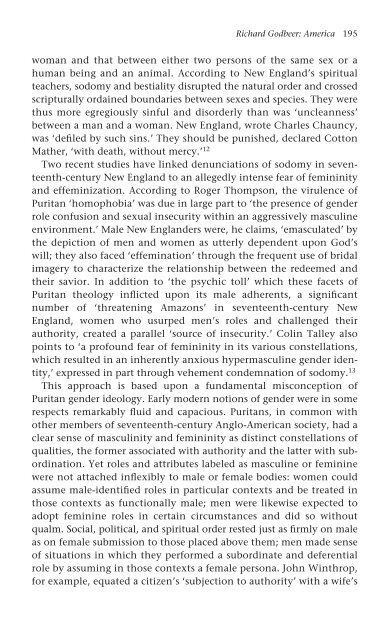queer masculinities
queer masculinities
queer masculinities
You also want an ePaper? Increase the reach of your titles
YUMPU automatically turns print PDFs into web optimized ePapers that Google loves.
Richard Godbeer: America 195<br />
woman and that between either two persons of the same sex or a<br />
human being and an animal. According to New England’s spiritual<br />
teachers, sodomy and bestiality disrupted the natural order and crossed<br />
scripturally ordained boundaries between sexes and species. They were<br />
thus more egregiously sinful and disorderly than was ‘uncleanness’<br />
between a man and a woman. New England, wrote Charles Chauncy,<br />
was ‘defiled by such sins.’ They should be punished, declared Cotton<br />
Mather, ‘with death, without mercy.’ 12<br />
Two recent studies have linked denunciations of sodomy in seventeenth-century<br />
New England to an allegedly intense fear of femininity<br />
and effeminization. According to Roger Thompson, the virulence of<br />
Puritan ‘homophobia’ was due in large part to ‘the presence of gender<br />
role confusion and sexual insecurity within an aggressively masculine<br />
environment.’ Male New Englanders were, he claims, ‘emasculated’ by<br />
the depiction of men and women as utterly dependent upon God’s<br />
will; they also faced ‘effemination’ through the frequent use of bridal<br />
imagery to characterize the relationship between the redeemed and<br />
their savior. In addition to ‘the psychic toll’ which these facets of<br />
Puritan theology inflicted upon its male adherents, a significant<br />
number of ‘threatening Amazons’ in seventeenth-century New<br />
England, women who usurped men’s roles and challenged their<br />
authority, created a parallel ‘source of insecurity.’ Colin Talley also<br />
points to ‘a profound fear of femininity in its various constellations,<br />
which resulted in an inherently anxious hypermasculine gender identity,’<br />
expressed in part through vehement condemnation of sodomy. 13<br />
This approach is based upon a fundamental misconception of<br />
Puritan gender ideology. Early modern notions of gender were in some<br />
respects remarkably fluid and capacious. Puritans, in common with<br />
other members of seventeenth-century Anglo-American society, had a<br />
clear sense of masculinity and femininity as distinct constellations of<br />
qualities, the former associated with authority and the latter with subordination.<br />
Yet roles and attributes labeled as masculine or feminine<br />
were not attached inflexibly to male or female bodies: women could<br />
assume male-identified roles in particular contexts and be treated in<br />
those contexts as functionally male; men were likewise expected to<br />
adopt feminine roles in certain circumstances and did so without<br />
qualm. Social, political, and spiritual order rested just as firmly on male<br />
as on female submission to those placed above them; men made sense<br />
of situations in which they performed a subordinate and deferential<br />
role by assuming in those contexts a female persona. John Winthrop,<br />
for example, equated a citizen’s ‘subjection to authority’ with a wife’s


